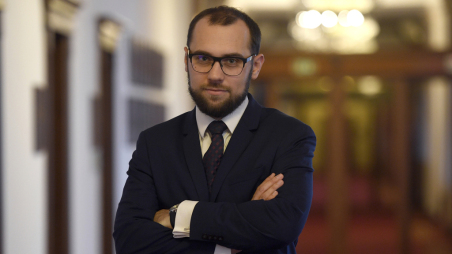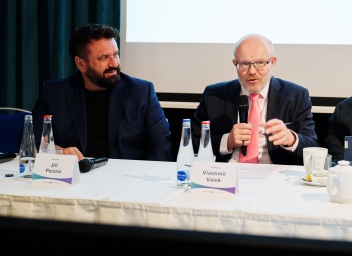There are various factors contributing to the problem of differences in access and delays of access to medicines across the EU. Thomas Allvin, Executive Director for Strategy and Healthcare Systems at EFPIA, brings to the table a proposal from the pharmaceutical industry in Europe, with tools such as value-based pricing, new payment models and an equity-based tiered pricing system, which he believes can lead to more equitable access to medicines in Europe. He said more about bridging the gaps between Member States in an exclusive interview with the Healthcare Daily which took place during a recent conference of the Czech Association of Innovative Pharmaceutical Industry (AIFP).
During the conference, we heard presentations on the results of an analysis, which mapped the root causes of the disparity in access to medicines across the European Union. Before we look at the specific outputs of this analysis, let’s talk about the reasons and background to the study. Why did EFPIA decide to look at this issue in such detail?
The access and availability of medicines in Europe and the difference between countries is one of the big political questions in health policy debates in Europe. And for good reasons. EFPIA has for many years been tracking it through the W.A.I.T. report, where we map the access delays and unavailability. We have been publishing for many years where you can see the differences in access and you can see the different delays. When we published these reports, many asked “why” – what are the causes. Is it because of the pharma industry not doing the job, or the member states? Who is to blame? That’s what the patients want to know. So we wanted to go one step further and try to understand what are the causes behind it.
What reasons for the different availability of modern medicines emerged from the analysis?
It’s a multifactorial thing. Getting medicines to patients is a long and complicated process with many steps. There are many causes behind it. First you have the speed of the regulatory process in the European Medicines Agency and then it’s about getting it to the different countries. So it’s the speed of the initiation of the process, when the pharma company files for pricing reimbursement in a country and then it’s the speed of the national pricing reimbursement process. The national procedure goes into other issues such as evidence requirements – meaning what kind of evidence does the national authorities need on the clinical effect of the medicine. And also the discussion about the relationship between value and price. Beyond that, it’s about if there is a sufficient budget in the country.
Mohlo by vás zajímat
What do you mean?
Different countries spend different amounts on healthcare. There are differences in GDP per capita between countries, and also in how much countries spend on healthcare as a percentage of GDP. And if you don’t have that much healthcare budget to begin with, you also have less for medicines, so you can’t pay for it even if you wanted to. It’s a long range of factors – many are about the national process that impacts behaviors of the companies.
So when companies choose to launch in different countries they know how it works in them. Some countries have national rules that say that for us to set a price we need first decisions from a number of other countries and then we will choose the lowest price of those. Or they want to know that this is already reimbursed in other countries. Then you have to wait before you can go to this country. It is a complex interaction between different countries and the pharma companies who are trying to respond to these factors.
Which of them are the most important from your point of view?
I have to pick two. One is the budget room – how much are you willing to pay for value, for innovation, for improved health outcomes for patients. And then it’s the evidence requirement. Especially with new advanced therapies coming such as cell and gene therapies which really are a paradigm shift for patients who have for instance a genetic disorder. These are for very small patient groups and the clinical trial data is limited – because you can’t do a clinical trial with thousands of patients – so there’s limited data. Payers and the Member States struggle how to assess and value this.
And then you get into discussion on the price. Here is where better use of health data and better alignment across the EU countries, on what kind of evidence should we ask for and what kind of evidence do we want the manufacturers to develop, will help.
Based on the results of the study, what needs to change to make the availability of innovative medicines as equal as possible for European patients? And is this even realistic? What will it take?
It is realistic and it’s something we have to strive for. We might not be able to achieve perfection but we need to strive for that. EFPIA companies have made a commitment over a year ago to file for pricing reimbursement no later than two years after the central authorization by the European Medicines Agency. This is our way to show that we want to help with the start of the process, to make sure that we at least get off the ground. That’s one of the parts that companies can to some extent control. This shows our commitment to more equal access.
Then the Member States authorities need to be on the other side and pick this up – have an efficient process and the commitment to actually fund this. So it will require both parties coming to the table.
What role does, or should, Health Technology Assessment (HTA) play in the whole process?
It plays a very important role. The EU HTA regulation is one of the pieces that hopefully can improve this. It is supposed to harmonize what clinical evidence is asked for at the beginning of the process. We are hoping this will be implemented well.
We have some worries that it won’t be as harmonized and streamlined as we thought, but instead a bundle of different evidence requirements from different countries that will not necessarily make this easier than today. But if we can get this right, that would be a huge help to harmonize this across the EU. HTA is also the basis for the value-based systems where you pay for health outcomes – that’s in the end what the health system is there for.
If you could describe value-based pricing more. What is it and how could it be used within health systems to increase access to medicines?
Value-based pricing is the principle that the price of an innovative medicine that is under patent protection should reflect the value it brings to patients but also to broader societies. So when you meet in a negotiation between a company and a payer on what’s the reasonable price for a particular medicine, according to this principle that should reflect the value it brings. It shouldn’t reflect other things such as the price in other countries.
This would create the most efficient signals back to the manufacturers what to invest in. It shows that you bring something with value for patients – that improves their health and quality of life, makes them able to go back to work, saves money elsewhere for the health system, prevents people from going to hospital. If there’s no correlation between the value and the price, then you don’t get that signal.
It’s about creating a rational system and it’s about not spending money on things that don’t work. It’s really a triple win for the health systems, the patients and the industry.
Another solution you have outlined is the increased use of new payment models in the process of pricing and reimbursement of medicines. How is your concept of new payment models different from the one that already exists in the Czech Republic?
There are many novel payment models. One is an “outcomes based agreement”, which is when you have a new therapy coming – for example a new cancer drug or cell and gene therapy – and the payer is uncertain about its effects, then you can do a specific agreement where you launch the medicine and then you track the patients‘ health outcomes and find out if they actually improved as was promised. If the medicine doesn’t deliver what was promised, then there is a payback or rebate according to the agreement. . So the final payment matches what the actual health outcomes are.
Another type of payment model is to spread the payment out over multiple years. That’s specifically for the new types of cell and gene therapies, which are one-off treatments, meaning they can cure a disease that was previously chronic, but it comes with a high upfront cost – that is the case for example for treating hemophilia.
You also talk about a system of pricing new medicines on the principle of solidarity between EU countries (Equity Based Tiered Pricing). How could this mechanism affect the availability of medicines on European markets?
Many companies already practice differential pricing – they modify pricing according to each country’s ability to pay. But it’s an imperfect system. What we’re proposing is to set up a more structured framework where we would have two tiers in Europe based on the GDP per capita and then we would have a rule that says that in the second tier, the highest price for a medicine must be lower than the lowest price in the first tier. This is a fair system, based on solidarity, where richer countries will pay a bit more – but they don’t have to pay more than today. This will help solve some of the issues around the misalignment between value and price and get medicines faster to the countries in tier two. That, of course, requires solidarity in Europe.
What reactions did you register in these richer countries to this proposal?
The reactions have been mixed. Most agree that this makes sense conceptually. Although some feel that it sounds complicated. Especially since many countries apply external reference pricing, which disturbs the system. There is also parallel trade where traders buy medicines in countries where they are relatively cheap and then sell them in other countries where they are more expensive. So that could also disrupt this framework. There are many things like this that we would have to tackle. We recognize these obstacles but at the same time think that it’s not a good reason for not sitting down with all the stakeholders and all the Member States and have a serious discussion.
Filip Krumphanzl







